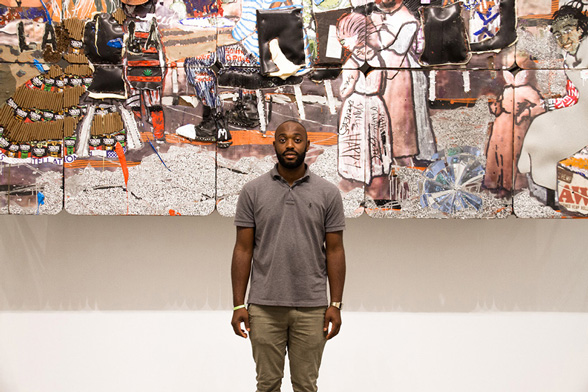Aaron Fowler on Michael Brown, intuition, and Frosted Flakes
The painter and assemblage artist Aaron Fowler uses unexpected materials to craft poignant messages in Aaron Fowler: Tough Love, an exhibition currently on view at Beeler Gallery.
The exhibition includes He Was, an impressive, room-filling piece about Ferguson, Missouri, shooting victim Michael Brown and his mother, Lezley McSpadden. The work is an altar-like installation that uses paint, hair extensions, rope, found plywood, and the eulogy McSpadden wrote for her son.
We talked to Fowler recently about his work.

Some of your pieces take a journalistic slant by telling the stories of others. Is that a goal for you in your work?
It’s a goal for my life, to be honest. I paint whatever it is that I’m going through. These paintings are me trying to figure out what’s going on in my life, and the result is what you see. The stories are pretty much my stories and how I encounter things.
Tell me more about what inspired the Michael Brown piece, He Was. Has his mother seen it?
I wasn’t going to make anything about that incident, and I try to stay away from political things. I don’t deal with politics in my life. But the politics are so heavy in St. Louis. When the shooting happened, I was at a mentor’s studio: Byron Kim. I was watching an interview with Michael Brown’s mother. She said, “He was my friend. My son. My love. He was about to go to school.” She expressed what he was to her. When I heard that, I cried because it reminded me how my mother thinks of me. I started this painting of her. I started with Madonna and child references. I wanted the painting to be about her. I wanted to make her strong. I put [the eulogy she wrote] on her first. Then I painted her image in black and white, because it is political. Then I put mirrors in her eyes, so that people can see themselves in that. Because at the end of the day, it’s about a mother who lost her child.
How did you feel at the end?
It felt good for a couple reasons. I made a breakthrough in my art, and I finally merged painting and sculpture. That felt good. I always feel good about art. It felt good to represent a mother in a beautiful way.
Michael Brown’s mother, Lezley McSpadden, hasn’t seen it yet. My aunt knows her and my stepdad met her. We’re trying to get her to see the piece in person. I’m hoping she’ll see it soon.
Where do you see the country moving in terms of race issues?
My experience is so weird in life. I’ve never been in any box. For me, race has always been an illusion, part of a matrix. At the end of the day, it’s about humanity. I don’t really see black and white. It’s kind of silly. It’s not a real thing unless you believe it’s a real thing. We all got our different problems, and we all come from our different boxes, and we’re all trying to be free and happy. It’s all bigger than racism. I don’t believe in it, therefore it doesn’t exist as much. The reason why it still exists is that we believe in it.
I see pieces of consumerist culture all over your work. Are you making a statement there?
I’m trying not to make any statements at all. It’s just me and my life. As I was making this black chair, I was really like, “I need silver lids. Where can I get silver lids? Let me see what I can find.” It’s an intuitive move. My intuition led me there. Our intuition is god; whatever god is to anyone is god. I just want to represent where I am and share that with people. I just make stuff. I don’t want to intentionally try to represent anything. I just follow ideas. I’ve never see my work until I step back.
You use Frosted Flakes in one of your pieces. Was there a reason? Why not Fruity Pebbles?
That’s another one of those intuitive, weird moves. I was making this piece at my mom’s house, and I wanted to make snow. Corn flakes is a silly metaphor for snowflakes. Corn flakes is my new snow now. I mixed it with paint and poured it on. I’m pretty sure I grabbed my mom’s Frosted Flakes and mixed it with corn flakes because it’s cheaper.
Tell me about your process. Do materials inspire bigger pieces or do you imagine a piece and then search out the materials that help tell that story?
Sometimes I’m walking between my studio and home and this god thing happens again. It’s this intuitive thing that hits you. I have this piece that I’m working on in New York about my brother leaving home. I found this pioneer painting of two parents and their kid is on his way to leave home. It’s the kid cleaning up and getting his life together. On this day, I end up walking from a coffee shop. To the left, I see a barbershop with a bunch of chairs. I end up getting all the materials there and was thinking about the image that I’m working on. The barbershop is where people go to clean up. It was a perfect metaphor about my brother looking to clean up. I don’t feel like anything is a coincidence. I love it. It’s the best thing ever. It’s such a cool process, the perfect process. My brother said that I should record what I do, because that’s the art.
____
Aaron Fowler: Tough Love is on view at Beeler Gallery through Sept. 10. Fowler will speak as part of the Beeler Gallery Visiting Artists & Scholars Series on Sept. 1. For more information, visit beelergallery.org.